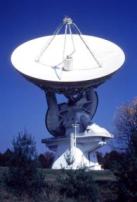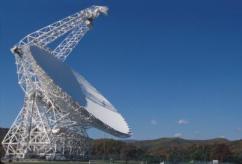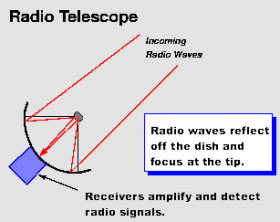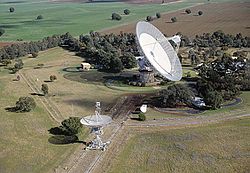Radio telescopes are used to study naturally occurring radio emission from stars, galaxies, quasars, and other astronomical objects between wavelengths of about 10 meters (30 megahertz [MHz]) and 1 millimeter (300 gigahertz [GHz]). At wavelengths longer than about 20 centimeters (1.5 GHz), irregularities in the ionosphere distort the incoming signals. This causes a phenomenon known as scintillation, which is analogous to the twinkling of stars seen at optical wavelengths. The absorption of cosmic radio waves by the ionosphere becomes more important as wavelength increases. At wavelengths longer than about 10 meters, the ionosphere becomes opaque to incoming signals. Radio observations of the cosmic sources at these wavelengths are difficult from ground-based radio telescopes. Below wavelengths of a few centimeters, absorption in the atmosphere becomes increasingly critical. At wavelengths shorter than 1 centimeter (30 GHz), observations from the ground are possible only in a few specific wavelength bands that are relatively free of atmospheric absorption. However, between 1 and 20 cm, the atmosphere and ionosphere introduce only minor distortions in the incoming signal. Sophisticated signal processing can be used to correct for these effects, so that the effective angular resolution and image quality is limited only by the size of the instrument.
Radio telescopes vary widely, but they all have two basic components: (1) a large radio antenna and (2) a sensitive radiometer or radio receiver. The sensitivity of a radio telescope--i.e., the ability to measure weak sources of radio emission--depends on the area and efficiency of the antenna and the sensitivity of the radio receiver used to amplify and detect the signals. For broadband continuum emission the sensitivity also depends on the bandwidth of the receiver. Because cosmic radio sources are extremely weak, radio telescopes are usually very large and only the most sensitive radio receivers are used. Moreover, weak cosmic signals can be easily masked by terrestrial radio interference, and great effort is taken to protect radio telescopes from man-made interference.
The most familiar type of radio telescope is the radio reflector consisting of a parabolic antenna--the so-called dish or filled-aperture telescope--which operates in the same manner as a television-satellite receiving antenna to focus the incoming radiation onto a small antenna referred to as the feed, a term that originated with antennas used for radar transmissions. In a radio telescope the feed is typically a waveguide horn and transfers the incoming signal to the sensitive radio receiver. Cryogenically cooled solid-state amplifiers with very low internal noise are used to obtain the best possible sensitivity.
In some radio telescopes the parabolic surface is equatorially mounted, with one axis parallel to the rotation axis of the Earth. Equatorial mounts are attractive because they allow the telescope to follow a position in the sky as the Earth rotates by moving the antenna about a single axis parallel to the Earth's axis of rotation. But equitorially mounted radio telescopes are difficult and expensive to build. In most modern radio telescopes a digital computer is used to drive the telescope about the azimuth and elevation axes to follow the motion of a radio source across the sky.
Observing times up to many hours are expended and sophisticated signal-processing techniques are used to detect astronomical radio signals that are as much as one million times weaker than the noise generated in the receiver. Signal-processing and analysis are usually done in a digital computer.
In the simplest form of radio telescope, the receiver is placed directly at the focal point of the parabolic reflector, and the detected signal is carried by cable along the feed support structure to a point near the ground where it can be recorded and analyzed. However, it is difficult in this type of system to access the instrumentation for maintenance and repair, and weight restrictions limit the size and number of individual receivers that can be installed on the telescope. More often, a secondary reflector is placed in front (Cassegrain focus) or behind (Gregorian focus) of the focal point of the paraboloid to focus the radiation to a point near the vertex of the main reflector. Multiple feeds and receivers may be located at the vertex where there is more room, less stringent weight restrictions and where access for maintenance and repair is more straightforward. Secondary focus systems also have the advantage that both the primary and secondary reflecting surfaces may be carefully shaped so as to improve the gain over that of a simple parabolic antenna.
While earlier radio telescopes used a symmetric tripod or quadrarpoid structure to hold the feed or secondary reflector, such an arrangement blocks some of the incoming radiation, and the reflection of signals from the support legs back into the receiver distorted the response. In newer designs, the feed or secondary reflector is placed off axis and does not block the incoming signal. Off axis radio telescopes are thus more sensitive and less affected by terrestrial interference reflected off of the support structure into the feed.
The performance of a radio telescope is limited by various factors: the accuracy of a reflecting surface that may depart from the ideal shape because of manufacturing irregularities; the effect of wind load; thermal deformations that cause differential expansion and contraction; and deflections due to changes in gravitational forces as the antenna is pointed to different parts of the sky. Departures from a perfect parabolic surface become important when they are a few percent or more of the wavelength of operation. Since small structures can be built with greater precision than larger ones, radio telescopes designed for operation at millimeter wavelength are typically only a few tens of meters across, whereas those designed for operation at centimeter wavelengths range up to 100 meters in diameter.
Traditionally, the effect of gravity has been minimized by designing the movable structure to be as stiff as possible in order to reduce the deflections resulting from gravity. A more effective technique, based on the principle of homology, allows the structure to deform under the force of gravity, but the cross section and weight of each member of the movable structure are chosen to cause the gravitational forces to deform the reflecting structure into a new paraboloid with a slightly different focal point. It is then necessary only to move the feed or secondary reflector to maintain optimum performance. Homologous designs have become possible only since the development of computer-aided structural analysis known as finite element analysis.
Radio telescopes are used to measure broad-bandwidth continuum radiation as well as spectroscopic features due to atomic and molecular lines found in the radio spectrum of astronomical objects. In early radio telescopes, spectroscopic observations were made by tuning a receiver across a sufficiently large frequency range to cover the various frequencies of interest. This procedure, however, was extremely time-consuming and greatly restricted observations. Modern radio telescopes observe simultaneously at a large number of frequencies by dividing the signals up into as many as several thousand separate frequency channels that may range over a total bandwidth of tens to hundreds of megahertz.
The most straightforward type of radio spectrometer employs a large number of filters, each tuned to a separate frequency and followed by a separate detector to produce a multichannel, or multifrequency, receiver. Alternatively, a single broad-bandwidth signal may be converted into digital form and analyzed by the mathematical process of autocorrelation and Fourier transformation (see below). In order to detect faint signals, the receiver output is often averaged over periods of up to several hours to reduce the effect of noise generated in the receiver.
Radio Interferometry and Aperture Synthesis
The angular resolution, or ability of a radio telescope to distinguish fine detail in the sky, depends on the wavelength of observations divided by the size of the instrument. Yet, even the largest antennas, when used at their shortest operating wavelength, have an angular resolution only a little better than one arc minute, which is comparable to that of the unaided human eye at optical wavelengths. Because radio telescopes operate at much longer wavelengths than do optical telescopes, radio telescopes must be much larger than optical telescopes to achieve the same angular resolution.
At radio wavelengths, the distortions introduced by the atmosphere are less important than at optical wavelengths, and so the theoretical angular resolution of a radio telescope can in practice be achieved even for the largest dimensions. Also, because radio signals are easy to distribute over large distances without distortion, it is possible to build radio telescopes of essentially unlimited dimensions. In fact, the history of radio astronomy has been one of solving engineering problems to construct radio telescopes of continually increasing angular resolution.
The high angular resolution of radio telescopes is achieved by using the principles of interferometry to synthesize a very large effective aperture from a number of small elements. In a simple two-element radio interferometer, the signals from an unresolved, or "point," source alternately arrive in phase and out of phase as the Earth rotates and causes a change in the difference in path from the radio source to the two elements of the interferometer. This produces interference fringes in a manner similar to that in an optical interferometer. If the radio source has finite angular size, then the difference in path length to the elements of the interferometer varies across the source. The measured interference fringes from each interferometer pair thus depend on the detailed nature of the radio "brightness" distribution in the sky.
Each interferometer pair measures one "Fourier component" of the brightness distribution of the radio source. Work by Australian and British radio astronomers in the 1950s and 1960s showed that movable antenna elements combined with the rotation of the Earth can sample a sufficient number of Fourier components with which to synthesize the effect of a large aperture and thereby reconstruct high-resolution images of the radio sky. The laborious computational task of doing Fourier transforms to obtain images from the interferometer data is accomplished with high-speed computers and the fast Fourier transform (FFT), a mathematical technique that is especially suited for computing discrete Fourier transforms.
In recognition of their contributions to the development of the Fourier synthesis technique, more commonly known as aperture synthesis, or earth-rotation synthesis, Martin Ryle and Antony Hewish were awarded the 1974 Nobel Prize for Physics. During the 1960s the Swedish radio astronomer, Jan Hogbom developed a technique called "CLEAN," which is used to remove the spurious responses from a celestial radio image caused by the use of discrete, rather than continuous, spacings in deriving the radio image. Further developments, based on a technique introduced in the early 1950s by the British scientists Roger Jennison and Francis Graham Smith, led to the concept of self-calibration, which is used to remove errors in a radio image due to uncertainties in the response of individual antennas as well as small errors introduced by the propagation of radio signals through the terrestrial atmosphere. In this way radio telescopes are able to achieve extraordinary angular resolution and image quality, not possible in any other wavelength band.
Very Long Baseline Interferometry (VLBI)
In conventional interferometers and arrays, coaxial-cable, waveguide, or even fiber-optic links are used to distribute a common local oscillator reference signal to each antenna and also to return the received signal from an individual antenna to a central laboratory where it is correlated with the signals from other antennas. In cases in which antennas are spaced more than a few tens of kilometers apart, however, it becomes prohibitively expensive to employ real physical links to distribute the signals. Very high frequency (VHF) or ultrahigh frequency (UHF) radio links can be used, but the need for a large number of repeater stations makes this impractical for spacings greater than a few hundred kilometers.
Interferometer systems of essentially unlimited element separation are formed by using the technique of very long baseline interferometry, or VLBI. In a VLBI system the signals received at each element are recorded by broad-bandwidth videotape recorders located at each element. The recorded tapes are then transported to a common location where they are replayed and the signals combined to form interference fringes. The successful operation of a VLBI system requires that the tape recordings be synchronized within a few millionths of a second and that the local oscillator reference signal be stable to better than one part in a trillion. A single magnetic tape capable of recording for several hours can contain one trillion bits of information, which is roughly equivalent to storing the entire contents of a modest-sized library. Hydrogen maser frequency standards are used to give a timing accuracy of only a few billionths of a second and a frequency stability of one part in a billion billion.












